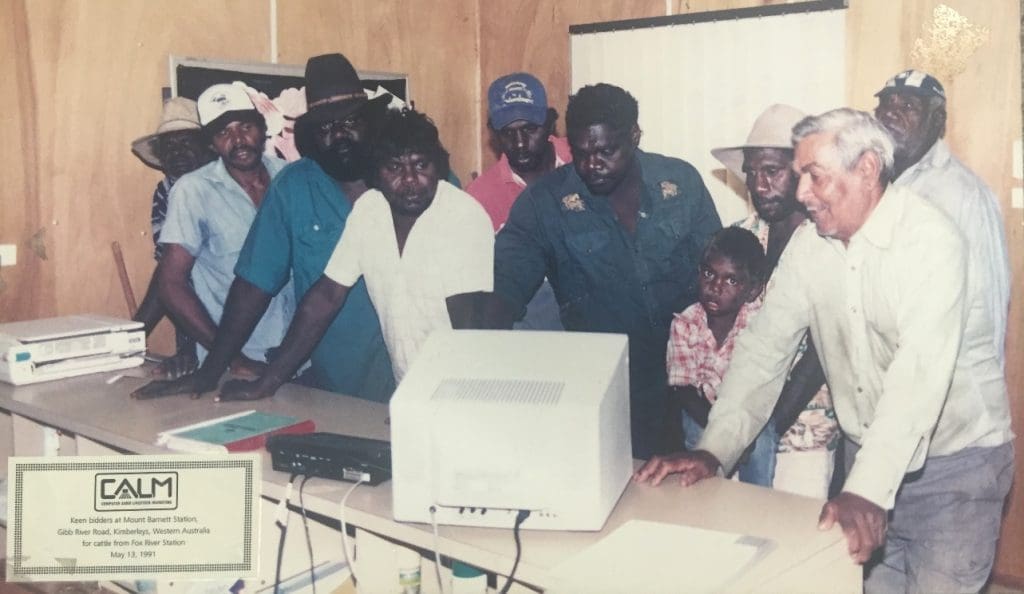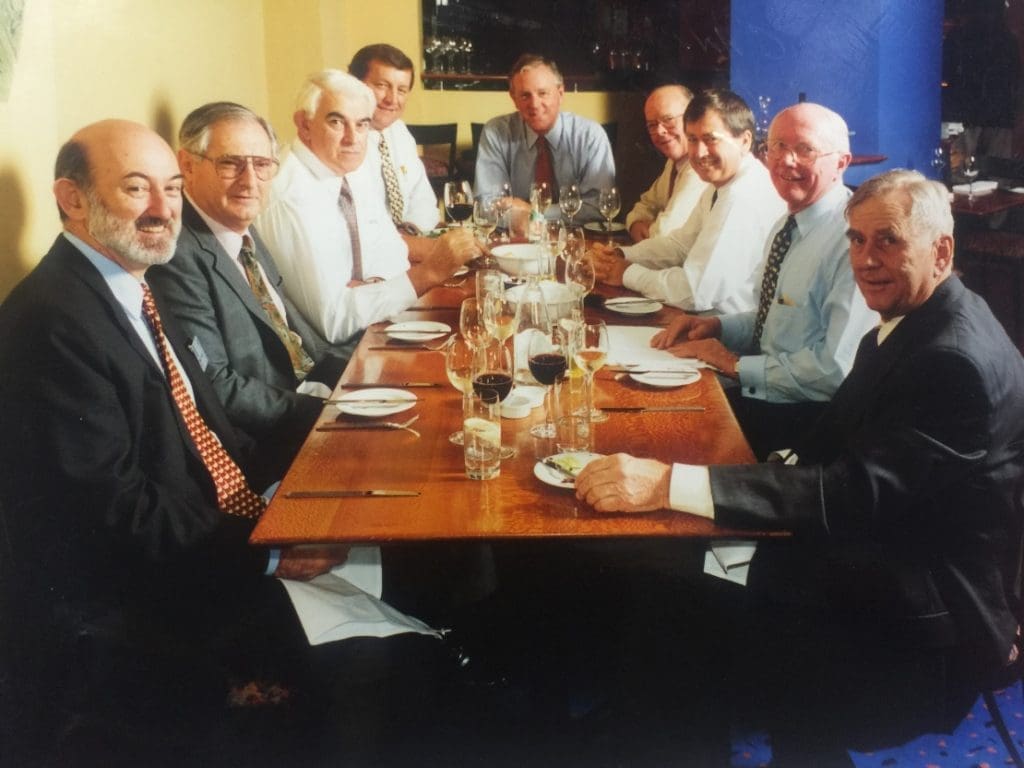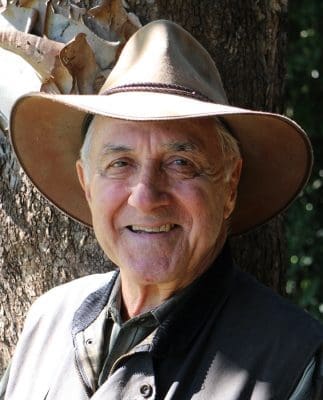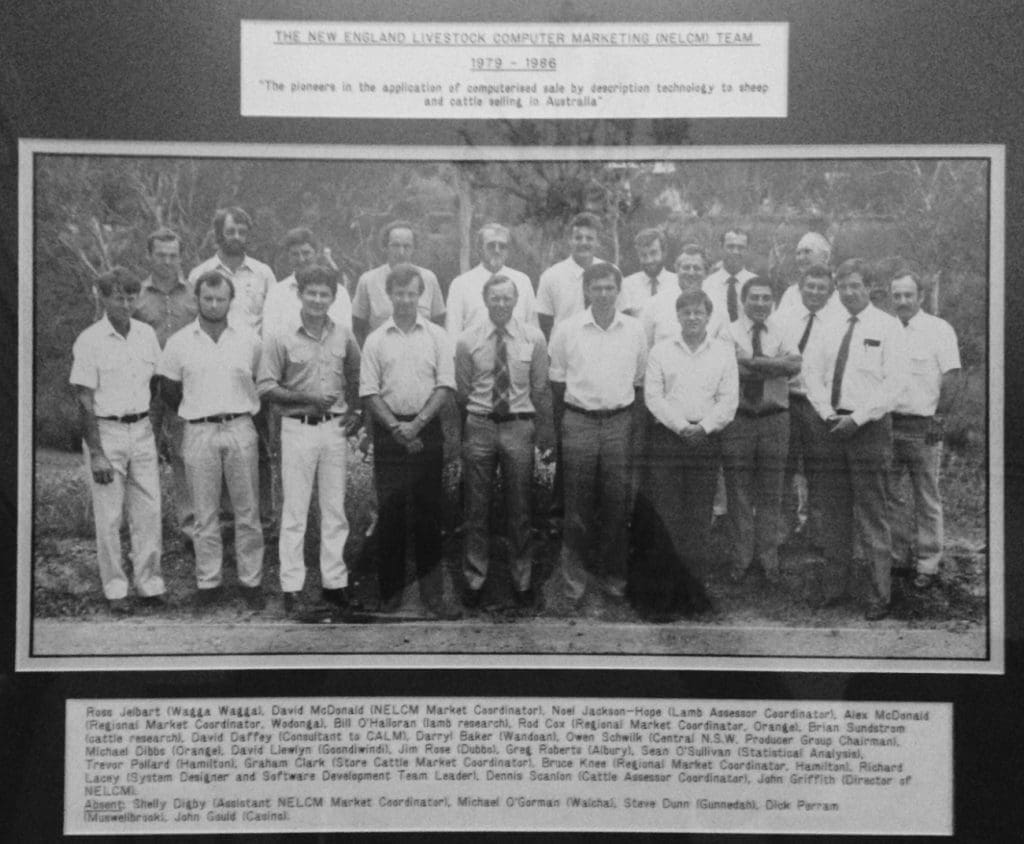A GALA celebration in Sydney on Thursday night will mark the passing of 30 years since the establishment of Australia’s world-leading online livestock marketing platform – originally known as Computer Aided Livestock Marketing, but later to become today’s AuctionsPlus.
Computer Aided Livestock Marketing, or CALM, came into being as a registered business this week in early June, 1986. The first trial cattle/sheep sale took place in October that year, before regular weekly sales commenced on July 1, 1987. CALM proudly announced that 68 people had connected electronically with its first commercial auction.

Watching a CALM auction unfold on remote Mt Barnett Station in the Kimberleys, 1991
Within weeks, some big lines of cattle were already being offered, including a mob of 2200 BTEC cattle from Tieyon Station in remote Central Australia, going to eight separate processor bidders in three states. The group assessments on the cattle had proven ‘extremely accurate’, with cows estimated at 205kg carcase weight killing out at 203kg, and steers within 7kg of actual kill weight.
By any measure, the notion of trying to sell cattle and sheep remotely – by electronic means using standardised description, rather than physical saleyards – was an audacious move for the era, showing enormous foresight and vision.
Keep in mind that all this occurred well before the arrival of the internet in Australia, before on-farm computers, and before faxes or mobile phones. Primitive telephone-coupled modems at incredibly slow access speeds were all that existed. Even telephone access in large parts of rural Australia was poor, or non-existent.
Forward-thinking among the project’s founders is an absolute understatement – what unfolded was so far ahead of its time, it was ridiculous.
It also took big kahoonas in terms of commitment of investment dollars to deliver a working prototype. The former Australian Meat & Livestock Corporation provided more than $1 million towards development work that ultimately led to CALM – a huge sum at the time.
While there were some clear drivers of the project in its conceptual and development phase, there’s no doubt there was an enormous collaborative effort behind the scenes, involving many stakeholders.
The harnessing of such a massive amount of hardware and software technology to make the system work was, by any standards, a mammoth task
Two New England graziers with foresight and enthusiasm who heavily drove the project in its early stages were David Wright, CALM’s inaugural chairman, and his cousin, Ed Wright.
David Wright devoted a great deal of time, expertise and energy to what was collectively being built in CALM.
“The harnessing of such a massive amount of hardware and software technology and power required to make the system work was, by any standards, a mammoth task,” Mr Wright said at the project’s commercial launch.
“But even that was nothing alongside the task of meeting the needs of so many disparate interests across the length and breadth of the cattle/sheep and meat supply chain across Australia,” he said.
“CALM will combine the advantages of direct consignment with the competitive bidding of an auction,” Mr Wright said during the program’s launch. “It will allow beef, sheep and pig producers to sell store or fat stock on the computer, before they leave the home property, and to sell them to a wider market.”
David Wright died in 2006. Former Beef CRC head, Prof Bernie Bindon, also a New England resident, described him as one of the pioneers of the scientific research outcomes which underpinned today’s beef industry.
“I can’t think of a beef industry person who’s made a bigger contribution to not only the growth of the Australian beef industry, but the science that underpins the beef business,” Prof Bindon said.

Last CALM board meeting before AuctionsPlus replaced it in 1996 – from left AMLC GM Bruce Standon, Graham Peart, Primary Industries minister John Kerin, Gerald Martin. John Wyld (chair), John Purcell, Les Dunstan, CALM GM Howard Gardner and Barry Hart.
CALM’s original chief executive was Howard Gardner; Graeme Forsythe was operations manager; and Dennis Scanlon was national livestock manager, moving across from a similar role at New England Livestock Computer Marketing (see references below). More than 20 software specialists were recruited to write programs for 30 software modules, newspaper reports of the day wrote.
Mr Scanlon managed 11 field officers and three state managers, who each ‘wore-out a couple of four-wheel drives’ criss-crossing the bush helping educate producers, agents and buyers on how the system worked, and what it had to offer.
Some of the very earliest ‘graduates’ of the CALM assessor courses in 1987, like Col Campbell at Landmark, and independent New England agent Bob Jamieson at Inverell, continue to support CALM with cattle and sheep on an almost weekly basis to this day.
So how reliable was the early technology?
“There were certainly times in the very early days of CALM when the technology and the connectivity did let us down,” Dennis Scanlon recalls, with some understatement.
“But it’s important to remember that this was blazing a trail – it was all brand new territory, and previously unseen technology,” he said.
“We can’t afford not to do it”
Mr Scanlon thinks that the hard financial times sustained by producers during the 1974-78 beef slump was one of the drivers that ultimately led to the development of CALM and its successor, AuctionsPlus.
“After three or four very tough years in the 70s, producers – particularly an active group across the New England – simply felt they had to do something about underpinning cattle prices. I have little doubt it was one of the contributing factors that led to the advent of CALM.”

Dennis Scanlon spent 5 years with NELCM, followed by 4 years with CALM as national livestock manager
Mr Scanlon recalls running into David Wright at a store sale in Moree, sometime before the launch of CALM.
“We sat after the sale, talking marketing,” Mr Scanlon said. “He showed me what potential there was for a ‘fairer’ return to cattle producers, processors and agents, from a more objective, more transparent and a more credible and honest marketing system. David’s final words in that conversation, which still ring in my ears, were: ‘Dennis, we can’t afford not to do it’.”
While groups like the New England Marketing Group headed by David Wright were active, others, including Ian Park, Maurie Binstead and John Purcell forged the Queensland Cattlemen’s Union, and similar groups were formed through Victoria, Tasmania and Western Australia. AMLC in 1986 committed $2.8 million to underpin the new CALM system, before it became self-supporting and was sold to agency networks including Elders and Dalgety (later Landmark) in 1997. AMLC chairman Dick Austen shared much of the vision for CALM, being promoted by David Wright and others. Much later, Ruralco joined the other agency owners, taking a one-third share. AMLC/MLA ultimately invested $17m supporting CALM/AuctionsPlus operations between 1985 and its sale to commercial interests in 1997.
Some agents saw CALM as a threat
While technology today has allowed AuctionsPlus to function at a whole new level, including embedded videos and photographs and live streaming of sales, many of the fundamentals that were pioneered in terms of the language and methodology that was applied in the early CALM days remain.
From day-one, the CALM concept faced some uphill battles to establish a foothold in the livestock marketing industry, however.
Most obvious of these was the view shared by some that CALM represented a threat not only to the well-entrenched saleyards selling system, but also to the livestock agency profession in general.
While agency stakeholders like Elders and Dalgety (or Landmark, as it is now) were supportive of CALM at the board and senior management level, the same could not be said at branch level, where many company and independent stock agents saw CALM as a threat to their livelihoods.
Fortunately there were enough big-picture-thinking agents around who saw CALM as a valuable marketing tool, rather than as a threat to their business, to allow the system to take root.
As the accompanying early promotional videos show, CALM had a vision to take its platform well beyond cattle and sheep, selling everything from seafood to fine art using the same principles. Technology has obviously come a long way since these explanatory videos were put together in 1987, when Commodore 64’s were the standard computer used. Click links below to access these fascinating historic videos:
Just one of the big early milestones after the program started was the move to group assessment over individual animal assessment, making CALM much better aligned with larger lines of stock.
NELCM pioneered much of the technology that led to CALM
Today’s AuctionsPlus system can trace its roots back well before the arrival of CALM in 1986, particularly to an ambitious development project driven out of the University of New England in Armidale called New England Livestock Computer Marketing (NELCM).
NELCM is regarded as the key pioneer in the application of computerised sale by description technology in Australia. To say it was THE pioneer that led to CALM is perhaps an overstatement, however, as there were a surprising number of other rudimentary sale-by-description mechanisms emerging at the time.
Most, but not all of these, were initiated by the stock and station agency sector, but development was discontinued with the advent of CALM. Crucially, none were computer-based, however, but relied mostly on telex or telephone service to link bidders with the auction process.
Some of those early sale-by-description projects included:
- Telstock WA – a Wesfarmers initiative that started sales in 1977
- CLASS WA – Run by the WA Dept of Ag using modified NELCM software
- Livestock Link – Telephone-based system initiated by Farmers and Graziers in 1981
- QUEST – Queensland based system run by the Livestock and Meat Authority.
- Tasmanian Livestock Exchange – Initiated by Roberts/Stewart and Websters, commenced sales in 1983.
- Elders Video Auctions – Started in 1983 using a grid system. Discontinued with the commercial roll-out of CALM. In April 1986 Elders held a ‘Multi-technology’ cattle sale at Jeogla Station near Armidale, using video-taped TV footage of cattle involved in the sale for the benefit of outside bidders, and a conference-call bidding process.
The conceptual development of the trail-blazing NELCM project began as far back as 1979, operating from a small office at the Agricultural Business Research Institute at UNE. It provided many of the foundations for the launch of CALM that was to follow in 1986.
AMLC, together with the Australian Meat & Livestock Research and Development Corporation provided a very considerable $1.02 million in research grants over seven years to fund the project.
Commercial sales of prime cattle on NELCM started in February 1982, followed by prime lamb a year later. By 1984 store cattle and sheep sales were underway, and sales attracting stock from Qld, NSW, Victoria, Tasmania and SA continued on a weekly basis until October 1986, just before CALM came into being.
The original system relied on telex communication, but in 1985 bidding started via Commodore 64 portable computers. The last NELCM sale was held in October 1986, with pre-commercial launch CALM sales beginning the following month.
Ultimately, NELCM proved that cattle, sheep and lambs could be traded on a wide-ranging basis of types and different regions of Australia, and that buyers would engage – especially after confidence grew in assessments and the feedback provided.

NELCM development team 1979-86
The director of NELCM was agribusiness identity John Griffith, who went on to become the chief executive of the Australian Agricultural Co, and later still, AustAsia.
Mr Griffith drove the NELCM project with great enthusiasm from 1979 until its hand-over to CALM. He acknowledged the brilliance of Rick Lacey, who was responsible for the system design and commercial enhancements. Arthur Rickards was another key team member, attracting funds for the project, significantly assisted by Dr Mike Jones, who contributed his considerable knowledge of computers. Brian Sundstrom was also an important member of the team, in developing assessor training and extension activities.
Other important members of the NELCM team were David McDonald (Market Coordinator), Dennis Scanlon (cattle assessment coordinator), Noel Jackson-Hope (lamb assessment coordinator), Graham Clark (store cattle assessment coordinator) and Rod Cox (regional coordinator).
Nor would the NELCM project have succeeded without the support of meatworks operators, livestock agents and livestock producers, many of whom took a risk in giving their support.
One of the early strong supporters was Queensland processor, Warwick Bacon (John Dee) led by Barry Hart, whose slaughter cattle purchasing on the system gave confidence to a wide range of abattoir operators to follow suit.
However NELCM would not have started without the foresight and enthusiasm of a group of New England graziers, especially David and Ed Wright. Once the system got going, its expansion was assisted by Rick Wright, who introduced a combined saleyard sale with computer bidding (now known as interface selling), so that buyers physically present competed with buyers remotely located using their computers to bid.
CALM/NELCM led to host of important industry innovations
The progress in the development of NELCM/CALM also stimulated the evolution of a number of other important industry tools, now in everyday use across the cattle industry.
Perhaps the most important of these was portable loadcell scales, used to weigh cattle on-property.
One of the first issues raised by buyer consultative groups when NELCM got underway was how the buyer would know what a line of sale cattle would weigh, beyond an assessor’s ‘dead reckoning.’
John Griffith and the NELCM team approached Rudds at Guyra (now Ruddweigh) and asked them, with valuable assistance from CSIRO, to develop a light, portable loadcell scale that could be used by assessors moving from property to property. That was the origin of today’s widely-used electronic scales fitted in thousands of crushes and station yards across Australia, replacing heavy and permanent clock-face scales that only existed in larger centres.
The other spin-offs from NELCM/CALM are considerable, and include the development of live animal assessment procedures, the general availability of livestock insurance.
Another was the development of more sophisticated assessment techniques for cattle, sheep and lambs, through AusMeat. These techniques included actual weight samples (using the new load-cells described above), manual fat cover estimates with accent on evenness of fat cover, quality and description of feed available and estimates of weight at delivery – plus horn status and temperament. All were all put together to deliver an accuracy of assessment not previously seen before the NELCM trial.
“The assessment process went on to give CALM a huge level of credibility,” Dennis Scanlon said.
“I still get comments from agents and producers today that the NELCM assessments taught them a lot about their animals, and got them a lot closer to identifying the premium aspects of fat and muscle distribution,” he said.
Today Australia’s biggest ‘saleyard’
Today, AuctionsPlus can lay claim to being the single largest ‘saleyard’ in Australia, by volume. Last calendar year, the system offered 349,000 head of cattle and 2.2 million sheep – both believed to be calendar year volume records. A total of 2175 buyers were involved, representing all states and territories. More than 3000 stakeholders posted bids. Biggest single cattle buyer on the system last year was Bindaree Beef at Inverell, sourcing both slaughter stock, as well as feeders. Cattle sales last year grossed $286 million, while sheep turnover grossed $173 million.
In the 29-year period from 1986 to the end of 2015, AuctionsPlus has turned over about four million cattle and 35 million sheep.
Thirty years on, the creation of a computerised livestock auction facility in AuctionsPlus now sells around $460 million worth of livestock each year, benefiting thousands of beef and sheep industry stakeholders across Australia.
- Click on photo gallery below to see more photos connected with AuctionsPlus’s early history.
- Click here to access info about Thursday’s Sale Day 30th anniversary celebrations including charity auctions.

Its was the first tender I ever worked on soon after arriving in Sydney in 1981 , so about 1985 ..
My pleasure to work with Dr Arthur Rickards and Phil ? and Peter Onley ( of CAS computer bureau ) and Jim Black ( where are they now ? )
Congratulations to all involved. Well done…and a great outcome!
A phenomenal effort for the era, from which we all continue to benefit.
Probably worth a mention too is that 2015 gave us the unheralded milestone of 30 years of BREEDPLAN emanating out of the same offices as NELCM , with R&D support from AGBU. ABRI has been a centre of innovation for the beef industry for 30 plus years.
We agree, Don. An unfortunate oversight on our behalf. Certainly not too late for a retrospective, though. Let’s get started. Editor
The first sale by description system was actually created to sell pigs with the venue being the Homebush saleyards in the late 1970’s. Fountain & Co, along with Partridge & Harvey and Richard Buck Stockmasters were the participating agents and it was held on a Friday -with no pigs present of course. From memory, David Coleman was the technical man who put “the system” together,
The sales went well for awhile but then fell victim to what I regard as producer greed when the dealers undermined the prices. At some stage it became uneconomic and it lapsed, then to be picked up by what became CALM.
Was it electronic, or telephone based, I wonder, Tony? Editor
Congratulations to all those involved in CALM and AuctionsPlus especially Howard Gardner, Garry Dick and the current CEO Anna Speer. Little did we imagine in the days of NELCM that our research plus developments paved by others would lead to the huge national selling network that AuctionsPlus is today. We are truly thrilled that 7 years of hard work at NELCM and one million dollars of industry money would help to create such a success. Many contributed, especially Howard Gardner who had to navigate the problems and misunderstandings of the commercial world after the researchers had left. Wishing you all a great 30 year birthday party and many more successful sales. Sale Oh!!
Likewise, the industry has a lot to be grateful for, through your hard work blazing the trail via NELCM from 1979, John. On behalf of our wonderful industry, we salute you and your team. Editor.